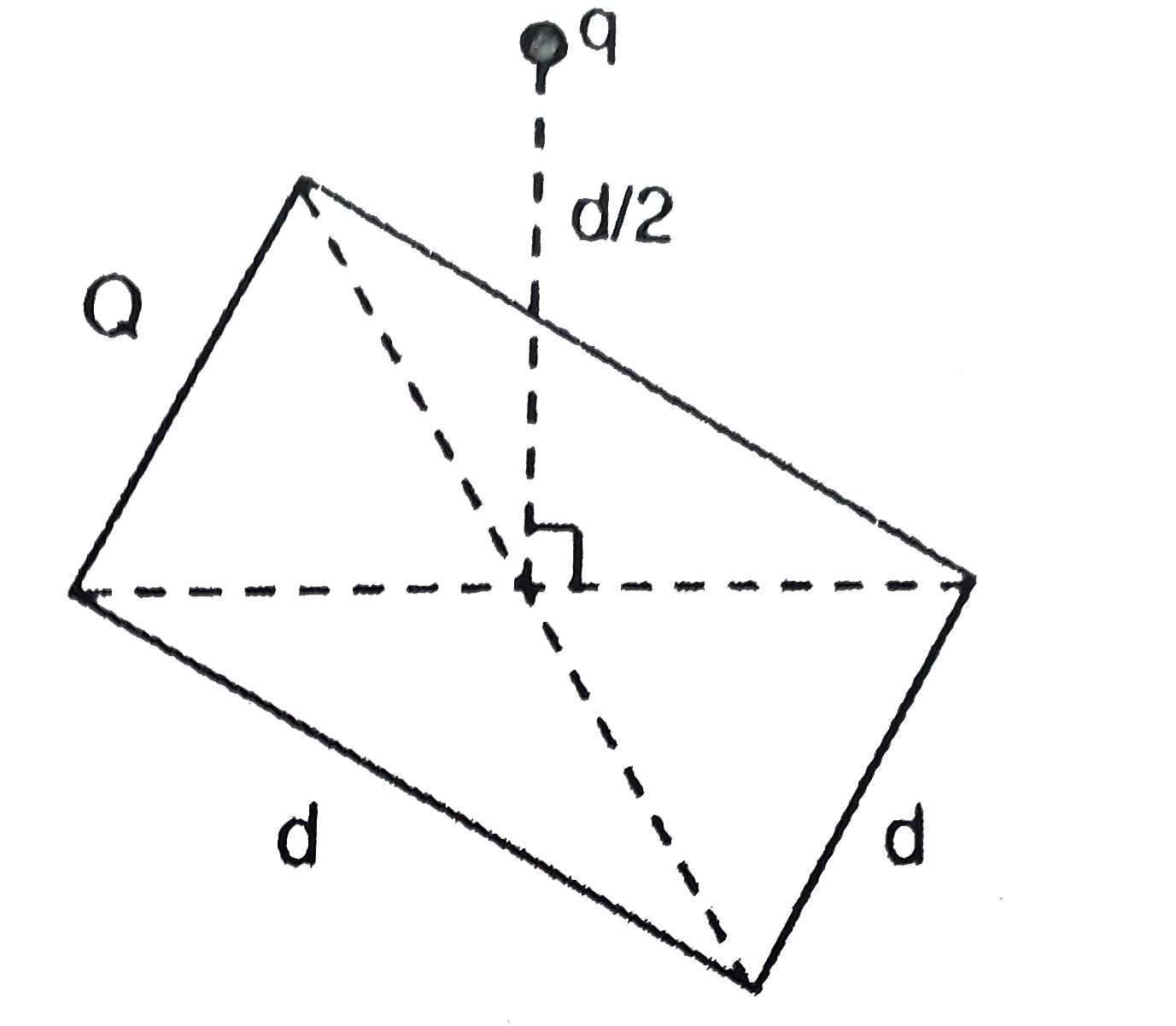A square of side d, made from a thin insulating plate, is uniformly charged and carries a total charge of Q. A point charge q is placed on the symmetrical normal axis of the square at a distance d/2 from the plate. How large is the force acting on the point charge ?

According to Newton's third law, the insulating plate acts on the point charge with a force of the same magnitude (but opposite direction) as the point charge does on the plate. We calculate the magnitude of this latter force.
Divide the plate (notionally) inot small pieces, and denote the area of the ith piece by ΔAi. Because of the uniform charge distibution, the charge on this small piece is ΔQi=Qd2ΔAi. and so the electric force acting on it is Fi=EiQi, where Ei is the magnitude of the electric field produced by the point charge q at the position of the small piece.
. The force acting on the insulating plate, as a whole, can be calculated as the vector sum of the forces acting on the individual pieces of the plate. Because of the axial symmetery, the net force is erpendicular to the plate, and so it is sufficient to sum the perpendicular components of the forces: :br" F=∑iFicosθi=∑iEiqd2ΔAicosθi=Qd2∑iEiΔAicosθi
Where θi is the angle between the normal to the plate and the line that connects the point charge to the its piece of it.
The Sum in the given expression is nothing other than the electric flux through the square sheet produced by the point charge q:ψ=q6ε0
Using this and our previous observations, we calculate the magnitude of the force acting on the point charge due to the presence of the charged insulating plates as F=Qq6e0d2

Topper's Solved these Questions
- ELECTROSTATICSBook:RESONANCE ENGLISHChapter:ELECTROSTATICSExercise:Part - II
Explore 23 Videos
- ELECTROMAGNETIC INDUCTIONBook:RESONANCE ENGLISHChapter:ELECTROMAGNETIC INDUCTIONExercise:A.l.P
Explore 19 Videos
- EXPERIMENTAL PHYSICSBook:RESONANCE ENGLISHChapter:EXPERIMENTAL PHYSICSExercise:PART -II
Explore 10 Videos
Similar Questions
A sperical shell is uniformly charged by a charge q. A point charge q0 is at its centre , then

View SolutionA point charge q is placed at the origin . How does the electric field due to the charge very with distance r from the origin ?
View SolutionA point charge Q is placed at the corner of a square of side a. Find the flux through the square.
View SolutionFigure shows a uniformly charged sphere of radius R and total charge Q. A point charge q is situated outside the sphere at a distance r from centre of sphere. Find out the following :
(i) Force acting on the point charge q due to the sphere.
(ii) Force acting on the sphere due to the point charge.

View SolutionElectric charge Q is uniformly distributed around a thin ring of radius a. find the potential a point P on the axis of the ring at a distance x from the centre of the ring .

View SolutionA ring of radius R carries a uniformly distributed charge +Q. A point charge −q is placed on the axis of the ring at a distance 2R from the centre of the ring and released from rest. The particle executes a simple harmonic motion along the axis of the ring. State True or False.
View SolutionA uniformly charged non-conducting spherical shell is given +q charge and a point charge -q is placed as shown. The electric field lines will be

View SolutionA uniformly charged square plate having side L carries a uniform surface charge density σ. The plate lies in the y−z plane with its centre at the origin. A point charge q lies on the x-axis. The flux of the electric field of q through the plate is ϕ0, while the foce on the point charge q due to the plate is F0, along the x-axis. Then,
View SolutionA point charge q is placed at a distance a/2 directly above the centre of a square of side a. The electric flux through the square is
View SolutionConsider a thin conducting shell of radius R carrying total charge Q. Two point charges Q and 2Q are placed on points A and B, which are at a distances of R2 and 2R from the center of the cell respectively as shown in the figure. If the cell is earthed how much charge will flow to the earth?
View Solution
